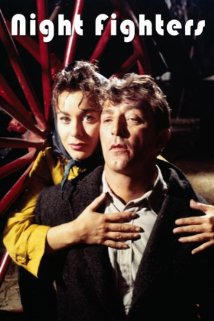The IRA in Northern Ireland during the last world war was in a strange boat.
Since, as is said in the Near East, “the enemy of my enemy is my friend,” there was naturally a certain positive attitude towards Nazi Germany. (You can find this social dynamic explicated by Fritz Heider, the German psychologist, if you like.) Well, the Nazis are mentioned here, and there is a broadcast by Lord Haw Haw, but other than that this is a story of the IRA against the British establishment in Northern Ireland.
What a tangled web they wove. And what a cast to be caught up in it. Robert Mitchum sounds passably Irish, and looks it too. His hair is long and curly and it gives him a poetic look. (How many times did he play an Irishman? I’m beginning to lose count.) Anne Heywood looks just fine but occasionally sounds as if she’s reading from cue cards. The rest of the cast give first-rate performances: Richard Harris, Dan O’Herlihy, and Cyril Cusack especially. O’Herlihy is, I think, an underrated actor. Here he does his “Odd Man Out” number, only he’s a good deal more ambitious here than there. He had considerable range: distant and deceitful in “Home Before Dark,” compassionate and humanistic in “Fail-Safe.” Likewise Cyril Cusack, who has a pretty interesting last name. It’s a common enough name in Ireland, but it was English before that, and before that it was brought from France by the Normans, to whom it was a location name (one who lived in Cotius’s place). It’s also a Ukranian name meaning “cossack.” Cyril Cusack is an exceptional performer. He was one of many excellent things about, “The Day of the Jackal,” in which he gave his finest performance, brief though it was.
Alas — fascinating political situation, wonderful cast — great potential wasted on a narrative that should have been polished. It isn’t that they don’t have the ethnographic details right, because they do. Mitchum is the “O’Neill boy,” although he’s 35. He’ll remain a “boy” until he’s married, an event which takes place late it life in traditional Irish villages. (That’s their form of birth control.) The Irish also practiced primogeniture, meaning that the oldest son gets the farm, skimpy as it is in this case, so poor Mitchum will have to get out on his own. And the script captures some of the ways the Irish tend to play with words. When Mitchum informs on the IRA inside the police station, the Sargent tells him that his friends are waiting outside to kill him, and Mitchum replies, “I think I’ll go home by the back way, pendin’ the coolin’ of their ardor.” (There’s a hilarious scene in “Angela’s Ashes” in which a teacher pities a young boy because “you’re so poor you haven’t a shoe to your foot.”)
But, the narrative is not taut. The characters and their motives are not clearly drawn, except in the way that cartoons are drawn. Not because of a deliberate attempt at ambiguity but through carelessness. Mitchum is entirely too casual when he joins the IRA, as if accepting a drink from a friend at the bar. And he informs on them with equal aplomb. O’Herlihy’s character is one-dimensional, a glory-hungry IRA commandant who is also the jealous, rejected lover of Mitchum’s girl. If the script is weak, so is Tay Garnett’s direction. Toward the end, O’Herlihy mistakenly shoots a young boy. No one bothered to include a shot of the boy falling from his bicycle.
Then O’Herlihy turns and runs away into the rain, and we never find out what happens afterward, leaving not just a loose thread hanging but a veritable hawser. Next, we get a quick change of scene to Mitchum and his girl sailing away on a ferry into the

